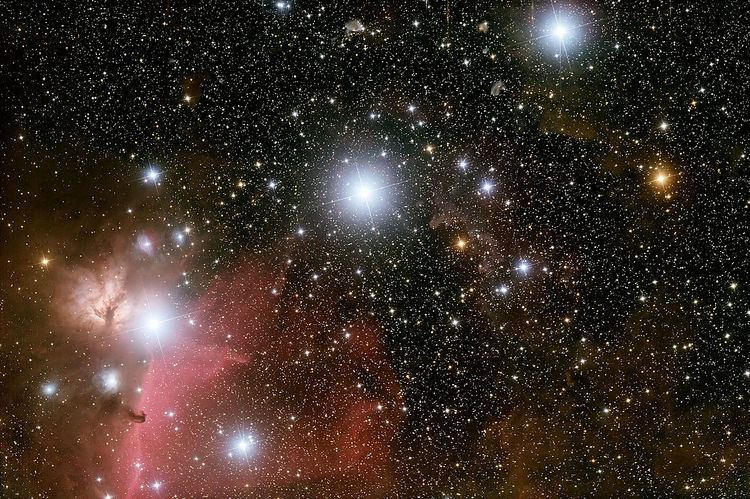Primary δ Ori Aa1 | Companion δ Ori Aa2 | |
 | ||
Mintaka, also designated Delta Orionis (δ Orionis, abbreviated Delta Ori, δ Ori) and 34 Orionis (34 Ori) is a multiple star some 1,200 light years from the Sun in the constellation of Orion. Together with Alnitak (Zeta Orionis) and Alnilam (Epsilon Orionis), the three stars make up the belt of Orion, known by many names among ancient cultures. When Orion is close to the meridian, Mintaka is the right-most of the belt's stars as seen by an observer in the Northern Hemisphere facing south.
Contents
Nomenclature
Delta Orionis is the star's Bayer designation, 34 Orionis its Flamsteed designation. The name Mintaka itself is derived from an Arabic term for 'belt': منطقة or manṭaqa. In 2016, the International Astronomical Union organized a Working Group on Star Names (WGSN) to catalog and standardize proper names for stars. The WGSN's first bulletin of July 2016 included a table of the first two batches of names approved by the WGSN; which included Mintaka for this star. It is now so entered in the IAU Catalog of Star Names.
Observational history
Mintaka is the westernmost of the three stars of Orion's belt. It is easily visible to the naked eye, one of the brightest stars in the sky, and has been known since antiquity.
Radial velocity measurements taken by Henri-Alexandre Deslandres at Paris Observatory showed that Mintaka had a variable radial velocity and therefore was a spectroscopic binary. His preliminary orbital period estimate of 1.92 days was shown to be incorrect in 1904 when Johannes Franz Hartmann using photographic plates taken at Potsdam Observatory showed that the orbital period was 5.7 days. Hartmann also noticed that the calcium K line at 393.4 nanometres in the stellar spectrum did not share in the periodic displacements of the lines due to orbital motion of the star and theorized that there was a cloud in the line of sight to Mintaka that contained calcium. This was the first detection of the interstellar medium.
System
Mintaka is a multiple star system with a magnitude 7 star about 52 arcseconds away from the main component and an even fainter star in between. The main component itself is triple: a class O9.5 bright giant and a class B main sequence star orbit every 5.73 days and exhibit shallow eclipses when the star dims about 0.2 magnitudes; and a B-class sub-giant is resolved 0.26" away. At the primary eclipse, the apparent magnitude (of the whole system) drops from 2.23 to 2.35, while it only drops to 2.19 at the secondary eclipse.
The seventh magnitude companion, HD 36485, is an unusual B-type main sequence star and itself a spectroscopic binary with a faint A-type companion in a 30-day orbit.
The 14th magnitude star is thought to be at the same distance, but it isn't clear whether it is physically bound to the primary star and little is known about it.
Mintaka is surrounded by a cluster of faint stars, possibly part of the cluster surrounding σ Ori.
The bright central star of the system is δ Ori A. Its components are generally referred to by researchers as Aa1, Aa2, and Ab, with HD 36485 referred to as Mintaka (or δ Ori) C, and the closer fourteenth magnitude companion as δ Ori B. Confusingly, some catalogues list δ Ori Ab as component B or component D, and Simbad names δ Ori Ab as Delta Orionis B.
Distance
The distance derived from the Hipparcos satellite parallax is 212 ± 30 pc, while spectroscopic distances, comparisons to similar stars, and cluster membership all suggest a value more than double that. This type of unreconcilable discrepancy is not unique to Mintaka and the reasons for it have yet to be clarified.
Etymology and cultural significance
Mintaka was also seen by astrologers as a portent of good fortune.
Orion's belt
The three belt stars were collectively known by many names in many cultures. Arabic terms include Al Nijād 'the Belt', Al Nasak 'the Line', Al Alkāt 'the Golden Grains or Nuts' and, in modern Arabic, Al Mīzān al H•akk 'the Accurate Scale Beam'. In Chinese mythology they were also known as The Weighing Beam.
The belt was also the Three Stars mansion (simplified Chinese: 参宿; traditional Chinese: 參宿; pinyin: Shēn Xiù), one of the Twenty-eight mansions of the Chinese constellations. It is one of the western mansions of the White Tiger.
In pre-Christian Scandinavia, the belt was known as Frigg's Distaff (Friggerock) or Freyja's distaff. Similarly Jacob's Staff and Peter's Staff were European biblical derived terms, as were the Three Magi, or the Three Kings. Väinämöinen's Scythe (Kalevala) and Kalevan Sword are terms from Finnish mythology.
The Seri people of northwestern Mexico call the three belt stars Hapj (a name denoting a hunter), which consists of three stars: Hap (mule deer), Haamoja (pronghorn), and Mojet (bighorn sheep). Hap is in the middle and has been shot by the hunter; its blood has dripped onto Tiburón Island.
In Spain and Portugal, this asterism is known as Las Tres Marías or As Três Marias, which stand for The Three Marys in Spanish and Portuguese respectively.
In Christian astromythology, Mintaka is also regarded as the third of the three Magi on their way to Bethlehem (Sirius): Caspar, Melchior, Balthasar.
Namesakes
The USS Mintaka (AK-94) was a United States Navy Crater-class cargo ship named after the star.
